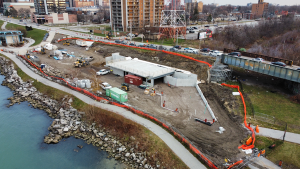The Winnipeg office of Dillon Consulting Inc. recently won an award of merit in the transportation category from Association of Consulting Engineering Companies – Manitoba (ACEC -MB).
Dillon won for contract administration and construction inspection services on a new bridge over the Assiniboine River and approach roadworks on the Yellowhead Highway (Provincial Trunk Highway16).
The bridge, which carries more than 1,600 vehicles per day, is located in a rural area five kilometres east of the Manitoba/Saskatchewan border and 300 kilometres northwest of Winnipeg.
The Yellowhead, as it is commonly called, is an east-west route and the main alternate road to the Trans-Canada Highway.
The first bridge, which was built in 1964, had exceeded its original design service life, was in poor condition and had been damaged by several spring floods. It was demolished as part of the same contract.
The project comprised a three-span replacement bridge 98 metres long and 12 metres wide that was built next to the original structure, plus approximately 1.8 kilometres of roadworks through the Assiniboine River valley, to tie in the existing roadworks with the new bridge.
Coco Paving Inc. was the project’s general contractor and did the roadwork, and M.D. Steel Construction Ltd. built the bridge.
“The bridge consisted of continuous concrete NU girders, was founded on steel H-piles with cast-in-place concrete semi-integral abutments and a cast-in-place concrete bridge deck with a waterproofing system and an asphalt overlay,” said Dillon partner Ron Weatherburn. “All of that is standard bridge-building practice in Manitoba.”
The new bridge was built to the south of the old one, at the bottom of the river valley.
“The roadway was shifted to the south as well,” said Weatherburn. “The project also involved river training works, which means that the river under the bridge had work done along the edges to reduce the potential for erosion.”
One of the main schedule constraints on the project was the flooding season. “Since the project was located in a flood-affected area, it was imperative that girder erection and the removal of crane pads from the Assiniboine River flood zone be completed by mid-March,” said Weatherburn.
On top of that, the girders had to be transported over 300 km from Winnipeg.
“With restrictions on travel times, as well as weather conditions during the Manitoba winter, it required considerable coordination to ensure safe and efficient transport to the project site,” said Weatherburn.
A challenge during construction of the bridge superstructure was the design of the bearings.
“The design detailed a single row of bearings per pier, which is not common on Manitoba infrastructure structures,” said Weatherburn. “The single row of bearings necessitated implementing temporary bearings until the pier diaphragms were completed and supported on the bearings.”
The new roadway alignment posed other challenges, because of the vertical and horizontal curve through the Assiniboine River valley. The elevation change from the edge of the project to the bridge is approximately 55 metres.
Overlap of the new road alignment with the existing road made for challenging traffic staging that would permit use of the highway during construction.
The project was the first contract administration and construction inspection (CACI) project for both bridge and road construction that Manitoba Infrastructure had issued to an engineering service provider.
In the past, says Weatherburn, Manitoba Infrastructure – now called Manitoba Transportation and Infrastructure (MTI) – did almost all of the construction administration of capital projects itself.
In 2019, MTI began to outsource both design work and CACI to outside consultants.
“This was the first project for MTI in which a consulting firm undertook the CACI work,” said Weatherburn. “A number of others since then have been overseen by consultants. It is our understanding that MTI will continue down this path, with most design and CACI work being done by engineering consulting firms in the future.”
In BC, Alberta, Saskatchewan and Ontario nearly all of this type of public sector work is done by engineering consultants.
Dillon’s award was accepted by Weatherburn and Katrine Levesque at the ACEC-MB 2022 award gala, which was held at Winnipeg’s Metropolitan Entertainment Centre in the spring.
A total of 13 awards were made this year, says ACEC-MB executive director Kerri Hiebert.
The “live” 2022 gala was the first such ceremony since 2019.
“There was no awards ceremony in 2020,” said Hiebert. “The 2020 awards were presented virtually in 2021.”
There were fewer project submissions in 2022 compared to past years, even after missing 2021.
“According to our member offices across Canada and our national CEO, this was a common occurrence,” said Hiebert.











Recent Comments
comments for this post are closed